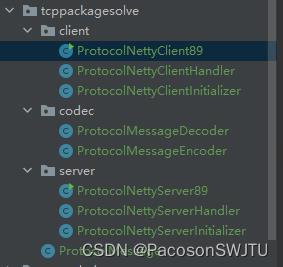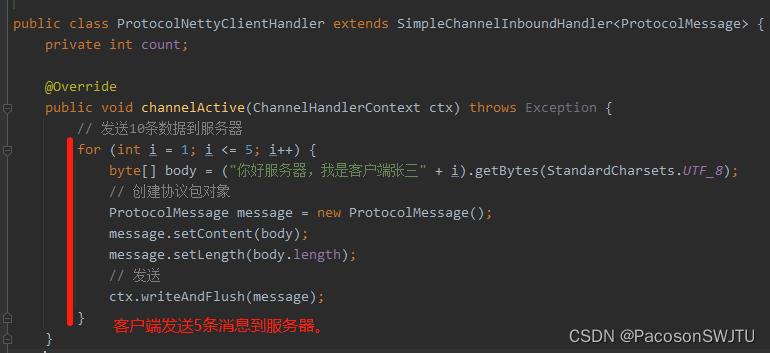Netty——解决TCP粘包、拆包
Posted
tags:
篇首语:本文由小常识网(cha138.com)小编为大家整理,主要介绍了Netty——解决TCP粘包、拆包相关的知识,希望对你有一定的参考价值。
参考技术ATCP是面向连接的,面向流的,提供高可靠性服务。收发两端(客户端和服务器端)都要有一一成对的socket,因此,发送端为了将多个发给接收端的包,更有效的发给对方,使用了优化方法(Nagle算法),将多次间隔较小且数据量小的数据,合并成一个大的数据块,然后进行封包。这样做虽然提高了效率,但是接收端就难于分辨出完整的数据包了,因为面向流的通信是无消息保护边界的。
由于TCP无消息保护边界, 需要在接收端处理消息边界问题,也就是我们所说的粘包、拆包问题。
假设客户端分别发送了两个数据包D1和D2给服务端,由于服务端一次读取到字节数是不确定的,故可能存在以下四种情况:
特别要注意的是,如果TCP的接受滑窗非常小,而数据包D1和D2比较大,很有可能会发生第五种情况,即服务端分多次才能将D1和D2包完全接受,期间发生多次拆包。
解决问题的根本手段就是找出消息的边界 。
Netty提供了以下三种方式解决TCP粘包和拆包问题:
DelimiterBasedFrameDecoder是通过发送方每条报文结束都添加特殊符号( $_ ) 作 为 报 文 分 隔 符,接收方通过特殊符号( $_ )对报文进行切割。
发送方需要自行编码,添加分隔符,编码如下:
接收方的解码如下:
缺点:发送的内容本身可能会出现分隔符,需要对发送的内容进行扫描并转义,接收到的内容也要进行反转义。
一种解决策略是,发送方对需要发送的内容预先进行base64编码,由于base64编码只包含64个字符:0-9、a-z、A-Z、+、/,我们可以选择这64个字符之外的特殊字符作为分隔符。
DelimiterBasedFrameDecoder提供了多个构造方法,最终调用的都是以下构造方法:
参数说明:
LineBasedFrameDecoder可以当成是一种特殊的DelimiterBasedFrameDecoder,其分隔符为\\n或者\\r\\n。
发送方的编码如下:
接收方的解码如下:
FixedLengthFrameDecoder是通过发送方固定每条报文长度均为n个字节,接收方也通过n个字节长度切分报文。
发送方需要自行补齐长度,编码如下:
接收方的解码如下:
缺点:如果发送的内容比较小,需要补齐长度,空间浪费,如果要发送的内容突然变大,需要调整发送方和接收方的长度。
LengthFieldBasedFrameDecoder的构造方法如下:
参数说明:
参考:
https://www.cnblogs.com/Leo_wl/p/10297113.html
https://www.cnblogs.com/sidesky/p/6913109.html
https://blog.csdn.net/u022812849/article/details/107254239
https://www.jianshu.com/p/c90ec659397c
https://network.51cto.com/art/201910/604438.htm
12.netty中tcp粘包拆包问题及解决方法
【README】
- 1.本文源代码总结自B站《netty-尚硅谷》;
- 2.本文介绍了tcp粘包拆包问题;
- 3.本文po 出了粘包拆包问题解决方案及源代码实现;
【1】tcp粘包拆包问题
refer2 How to deal with the problem of packet sticking and unpacking during TCP transmission? - 编程知识
【1.1】粘包拆包问题描述
- 假设客户端发送2个连续的数据包到服务器,数据包用packet1,packet2分别表示,则服务器接收到的数据可以分为3种情况;
1)情况1: 服务器接收到2个数据包,没有拆包,也没有粘包问题;

2)情况2: 服务器只接收到一个数据包(存在粘包问题)
- 因为tcp不会丢失数据包,因此这一个数据包就封装了2个原生数据包的信息,这种现象叫做粘包。
- 在这种情况,接收者并不知道2个原生包的界限,因此接收者很难处理;

3)情况3: 接收者接收到2个冗余或不完整的数据包(粘包与拆包问题同时发生)
- 接收者接收到2个数据包,但这2个数据包要么不完整,要么掺杂了其他数据包的部分数据。
- 在这种情况下,粘包与拆包同时发生。
- 如果这2个包不被特殊处理,对于接收者来说也很难处理;

【1.2】代码演示粘包拆包问题
注意:
- 限于篇幅,本节没有po出全部代码, 能够表达意思即可;
1)业务场景:客户端连续发送10条消息(字符串)到服务器,查看服务器接收情况;
2)客户端发送消息代码: 
3)服务器接收消息代码:

3.1)服务器接收消息的打印效果:
=================================
服务器收到的数据 hello server0
服务器累计收到 [1] 个消息包
=================================
服务器收到的数据 hello server1
服务器累计收到 [2] 个消息包
=================================
服务器收到的数据 hello server2
hello server3
hello server4
hello server5
hello server6
服务器累计收到 [3] 个消息包
=================================
服务器收到的数据 hello server7
hello server8
hello server9
服务器累计收到 [4] 个消息包【效果解说】
- 客户端发送了10条消息,服务器接收到了 4个数据包,而不是10个数据包 ;
- 显然,发生了tcp粘包;
- 这10条消息本来是10个数据报文,却被合并(粘)为4个数据包;
- 问题是: 如何把这4个数据包还原为10个数据包呢 (在高并发情况下,各式各样的数据包会更多)
- 如果无法还原,则服务器无法正确解析报文并做相应处理;
【2】 粘包与拆包原因
1)粘包原因:
- 发送的数据大小 小于 发送缓冲区,tcp就会把发送的数据多次写入缓冲区,此时发生粘包;
- 接收数据方的应用层没有及时从 接收缓冲区读取数据,也会发生粘包;
2)拆包原因:
- 发送的数据大小 大于 tcp发送缓冲区,就会发生拆包;
- 发送的数据大小 大于 报文最大长度,也会拆包;
【3】粘包拆包解决方法
解决粘包拆包的关键在于 为每一个数据包添加界限标识,常用方法如下:
- 方法1)发送方为每一个数据包添加报文头部。头部至少包含数据包长度(类似http协议的头部length)。 通过这种方式,接收方通过读取头部的长度知道当前数据包的界限,并在界限处停止读取。
- 方法2)发送方以固定长度封装数据包。如果不足,则补0填充。
- 方法3)自定义设置数据包的界限标识,如添加特别标识(如======)。接收方通过标识可以识别不同的数据包;
【4】粘包拆包问题解决的源代码实现
解决方法是:采用方法1,设置每个数据包的长度到报文头部;
【4.1】协议数据包封装类
/**
* @Description 协议数据包
* @author xiao tang
* @version 1.0.0
* @createTime 2022年09月10日
*/
public class ProtocolMessage
private int length;
private byte[] content;
/**
* @description 构造器
* @author xiao tang
* @date 2022/9/10
*/
public ProtocolMessage()
public int getLength()
return length;
public void setLength(int length)
this.length = length;
public byte[] getContent()
return content;
public void setContent(byte[] content)
this.content = content;
【4.2】服务器
1)服务器 :
public class ProtocolNettyServer89
public static void main(String[] args) throws InterruptedException
EventLoopGroup bossGroup = new NioEventLoopGroup(1);
EventLoopGroup workerGroup = new NioEventLoopGroup();
try
ServerBootstrap serverBootstrap = new ServerBootstrap();
serverBootstrap.group(bossGroup, workerGroup)
.channel(NioServerSocketChannel.class)
.childHandler(new ProtocolNettyServerInitializer()); // 自定义一个初始化类
// 自动服务器
ChannelFuture channelFuture = serverBootstrap.bind(8089).sync();
System.out.println("服务器启动成功");
// 监听关闭
channelFuture.channel().closeFuture().sync();
finally
bossGroup.shutdownGracefully();
workerGroup.shutdownGracefully();
2) 服务端初始化器:
public class ProtocolNettyServerInitializer extends ChannelInitializer<SocketChannel>
@Override
protected void initChannel(SocketChannel ch) throws Exception
ChannelPipeline pipeline = ch.pipeline();
// 添加入站解码器-把字节转为协议报文便于业务逻辑处理
pipeline.addLast(new ProtocolMessageDecoder());
// 添加出站编码器-把协议报文转为字节便于网络传输
pipeline.addLast(new ProtocolMessageEncoder());
// 添加业务逻辑handler
pipeline.addLast(new ProtocolNettyServerHandler());
3)处理器:
public class ProtocolNettyServerHandler extends SimpleChannelInboundHandler<ProtocolMessage>
private int count = 0;
@Override
protected void channelRead0(ChannelHandlerContext ctx, ProtocolMessage msg) throws Exception
// 接收到数据并处理
int length = msg.getLength();
String bodyStr = new String(msg.getContent(), StandardCharsets.UTF_8);
System.out.println("====================================");
System.out.println("服务器接收的消息如下:");
System.out.println("报文长度:" + length);
System.out.println("报文体内容: " + bodyStr);
System.out.println("服务器累计接收到的消息包数量 = " + ++this.count);
// 回复客户端
byte[] body = ("我是服务器" + count).getBytes(StandardCharsets.UTF_8);
int responseLen = body.length;
// 构建一个响应协议包
ProtocolMessage responseMsg = new ProtocolMessage();
responseMsg.setLength(responseLen);
responseMsg.setContent(body);
ctx.writeAndFlush(responseMsg);
@Override
public void exceptionCaught(ChannelHandlerContext ctx, Throwable cause) throws Exception
cause.printStackTrace();
ctx.close();
【4.3】客户端
1)客户端:
public class ProtocolNettyClient89
public static void main(String[] args) throws InterruptedException
EventLoopGroup group = new NioEventLoopGroup();
try
Bootstrap bootstrap = new Bootstrap();
bootstrap.group(group)
.channel(NioSocketChannel.class)
.handler(new ProtocolNettyClientInitializer()); // 自定义一个初始化类
// 连接服务器
ChannelFuture channelFuture = bootstrap.connect("localhost", 8089).sync();
channelFuture.channel().closeFuture().sync();
finally
group.shutdownGracefully();
2)初始化器:
public class ProtocolNettyClientInitializer extends ChannelInitializer<SocketChannel>
@Override
protected void initChannel(SocketChannel ch) throws Exception
ChannelPipeline pipeline = ch.pipeline();
// 添加出站处理器- 协议报文转字节以便网络传输
pipeline.addLast(new ProtocolMessageEncoder());
// 添加入站解码器-把字节转为协议报文对象以便业务逻辑处理
pipeline.addLast(new ProtocolMessageDecoder());
// 添加一个自定义handler,处理业务逻辑
pipeline.addLast(new ProtocolNettyClientHandler());
3)处理器:
public class ProtocolNettyClientHandler extends SimpleChannelInboundHandler<ProtocolMessage>
private int count;
@Override
protected void channelRead0(ChannelHandlerContext ctx, ProtocolMessage msg) throws Exception
// 读取服务器响应报文
int length = msg.getLength();
byte[] body = msg.getContent();
System.out.println("=============================");
System.out.println("客户端接收的消息如下:");
System.out.println("长度 = " + length);
System.out.println("报文体 = " + new String(body, StandardCharsets.UTF_8));
System.out.println("客户端累计接收的消息包数量 = " + ++count);
@Override
public void channelActive(ChannelHandlerContext ctx) throws Exception
// 发送10条数据到服务器
for (int i = 1; i <= 5; i++)
byte[] body = ("你好服务器,我是客户端张三" + i).getBytes(StandardCharsets.UTF_8);
// 创建协议包对象
ProtocolMessage message = new ProtocolMessage();
message.setContent(body);
message.setLength(body.length);
// 发送
ctx.writeAndFlush(message);
@Override
public void exceptionCaught(ChannelHandlerContext ctx, Throwable cause) throws Exception
cause.printStackTrace();
ctx.close();
【4.4】编码器与解码器
1)解码器
/**
* @Description 协议报文解码器
* @author xiao tang
* @version 1.0.0
* @createTime 2022年09月10日
*/
public class ProtocolMessageDecoder extends ByteToMessageDecoder
@Override
protected void decode(ChannelHandlerContext ctx, ByteBuf in, List<Object> out) throws Exception
System.out.println("ProtocolMessageDecoder.decode() 被调用");
// 把字节 转为 协议报文
int length = in.readInt();
byte[] body = new byte[length];
in.readBytes(body);
// 封装成 ProtocolMessage,放入out,送入下一个 Handler处理
ProtocolMessage protocolMessage = new ProtocolMessage();
protocolMessage.setLength(length);
protocolMessage.setContent(body);
// 添加到out
out.add(protocolMessage);
2)编码器 :
/**
* @Description 协议消息编码器
* @author xiao tang
* @version 1.0.0
* @createTime 2022年09月10日
*/
public class ProtocolMessageEncoder extends MessageToByteEncoder<ProtocolMessage>
@Override
protected void encode(ChannelHandlerContext ctx, ProtocolMessage msg, ByteBuf out) throws Exception
System.out.println("ProtocolMessageEncoder.encode() 被调用");
out.writeInt(msg.getLength());
out.writeBytes(msg.getContent());
【4.5】目录结构:

【4.6】打印效果:
1)客户端发送5条消息到服务器:

2)服务器接收的数据包为 5个,如下(显然没有发生拆包粘包问题):
ProtocolMessageDecoder.decode() 被调用
====================================
服务器接收的消息如下:
报文长度:40
报文体内容: 你好服务器,我是客户端张三1
服务器累计接收到的消息包数量 = 1
ProtocolMessageEncoder.encode() 被调用
ProtocolMessageDecoder.decode() 被调用
====================================
服务器接收的消息如下:
报文长度:40
报文体内容: 你好服务器,我是客户端张三2
服务器累计接收到的消息包数量 = 2
ProtocolMessageEncoder.encode() 被调用
ProtocolMessageDecoder.decode() 被调用
====================================
服务器接收的消息如下:
报文长度:40
报文体内容: 你好服务器,我是客户端张三3
服务器累计接收到的消息包数量 = 3
ProtocolMessageEncoder.encode() 被调用
ProtocolMessageDecoder.decode() 被调用
====================================
服务器接收的消息如下:
报文长度:40
报文体内容: 你好服务器,我是客户端张三4
服务器累计接收到的消息包数量 = 4
ProtocolMessageEncoder.encode() 被调用
ProtocolMessageDecoder.decode() 被调用
====================================
服务器接收的消息如下:
报文长度:40
报文体内容: 你好服务器,我是客户端张三5
服务器累计接收到的消息包数量 = 5
ProtocolMessageEncoder.encode() 被调用以上是关于Netty——解决TCP粘包、拆包的主要内容,如果未能解决你的问题,请参考以下文章